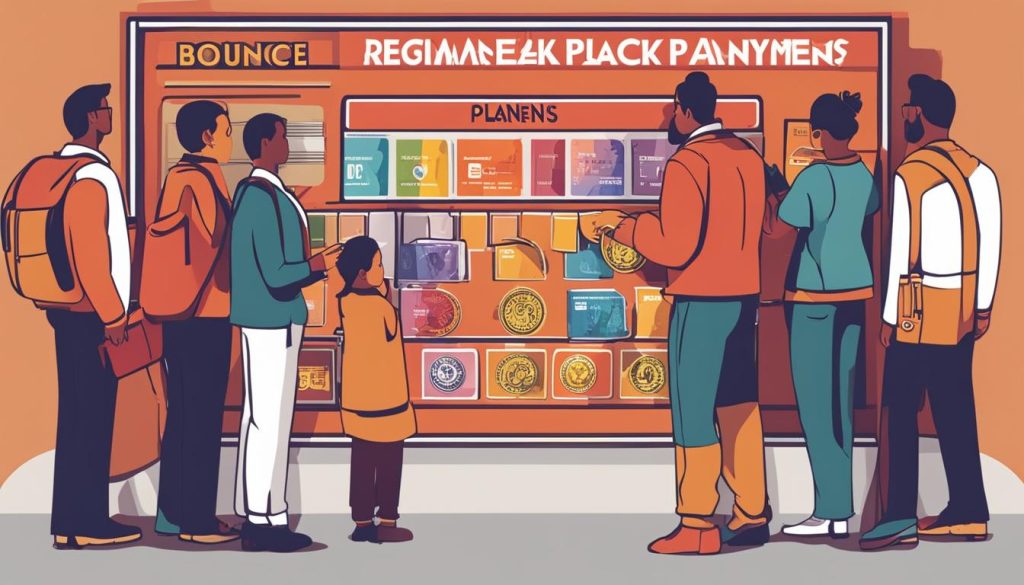Welcome to our guide on the Bounce Back Loan Scheme (BBLS), a small business loan program introduced by the government to support businesses during these challenging times. If you’re a business owner looking for financial assistance, this scheme could be the lifeline your business needs to recover and thrive again.
In the following sections, we’ll explore the eligibility criteria, the application process, repayment terms and options, as well as the pros and cons of the Bounce Back Loan Scheme. We’ll also help you assess if this scheme is the right fit for your business by considering various factors such as eligibility, loan amount needed, and repayment capacity.
Stay tuned as we dive deeper into the details of the Bounce Back Loan Scheme, one of the government’s initiatives to provide vital support to small businesses across the United Kingdom. Let us guide you through the application process so you can secure the financial assistance you need to bounce back and push your business forward.
What is the Bounce Back Loan Scheme?
The Bounce Back Loan Scheme (BBLS) was introduced by the UK government in response to the economic impact of the COVID-19 pandemic. It aimed to provide financial support to small and medium-sized enterprises (SMEs) affected by the crisis.
Under the scheme, eligible businesses could borrow between £2,000 and £50,000, up to a maximum of 25% of their turnover. The loans were interest-free for the first 12 months, with a fixed interest rate of 2.5% per annum thereafter.
The BBLS was designed to be quick and easy to access, with a simple online application process. It was available through a range of accredited lenders, including banks and financial institutions.
One of the key features of the scheme was its “bounce back” nature, allowing businesses to quickly access the funds they needed to survive and recover from the challenges posed by the pandemic.
Eligibility Criteria for the Bounce Back Loan Scheme
Businesses looking to apply for the Bounce Back Loan Scheme (BBLS) must meet specific eligibility criteria to qualify for financial assistance. Here are the key requirements:
- Based in the UK: To access the scheme, businesses must be registered and operating in the United Kingdom.
- Established before March 1, 2020: The BBLS is available to businesses that were set up and actively trading before the specified date.
- Adversely affected by the COVID-19 pandemic: Eligible businesses should demonstrate that they have experienced negative impacts due to the coronavirus crisis.
It’s important to note that certain types of businesses are not eligible for the Bounce Back Loan Scheme. These include banks, insurers, public-sector bodies, and state-funded schools. Additionally, if a business has already received financial support through other COVID-19 relief schemes, it may affect their eligibility for the BBLS.
By meeting the above eligibility criteria, businesses can take advantage of the Bounce Back Loan Scheme to secure funding for their recovery and navigate the challenges brought by the ongoing pandemic.

| Eligibility Criteria | Requirement |
|---|---|
| Location | Based in the UK |
| Establishment | Businesses established before March 1, 2020 |
| Adverse Effect | Businesses adversely affected by the COVID-19 pandemic |
| Ineligible Business Types | Banks, insurers, public-sector bodies, state-funded schools |
| Previous Support Schemes | Potential eligibility restrictions for businesses that have received funding through other COVID-19 relief programs |
Meeting the eligibility requirements is a crucial step towards accessing the Bounce Back Loan Scheme and securing financial support for small businesses affected by the current economic challenges.
How to Apply for the Bounce Back Loan Scheme?
Applying for the Bounce Back Loan Scheme is a simple process that can be done online. Here’s a step-by-step guide on how to apply:
- Find an accredited lender: Visit the official website of the British Business Bank to access the list of 29 accredited lenders participating in the scheme.
- Choose a lender: Select a lender that suits your business needs and preferences. Consider factors such as interest rates and customer reviews.
- Fill out the application form: Click on the lender’s website and look for the Bounce Back Loan application form. Provide accurate and up-to-date information about your business.
- Submit the application: Once you have filled out the form, submit it online through the lender’s website. Make sure to review the form for any errors or missing information.
- Wait for a decision: The lenders will review your application and assess your eligibility for the loan. This process typically takes a few days, but it may vary depending on the lender.
- Receive the loan: If your application is approved, you will receive the loan agreement from the lender. Carefully review the terms and conditions before signing.
- Start repaying the loan: Once you have received the loan, you will need to start making repayments. The repayment terms and options will depend on the lender you choose.
If your application is rejected by one lender, don’t lose hope. You can still apply to other lenders participating in the Bounce Back Loan Scheme. Additionally, if you need assistance with the application process or have questions, you can reach out to brokers who specialize in business loans or refer to the British Business Bank’s finance guide for more information.

Loan Repayment Terms and Options
The repayment terms and options for the Bounce Back Loan Scheme are designed to provide flexibility to businesses that may be struggling with repayment.
Loan Term
The Bounce Back Loan has a term of 6 years, allowing businesses ample time to repay the loan.
Early Repayment
Businesses have the option to repay the loan early without incurring any fees, providing them with the opportunity to reduce their debt burden.
Initial Repayment Holiday
No repayments are due during the first 12 months, giving businesses a breathing space to stabilize their finances before starting loan repayments.
Repayment in Full
After the initial 12 months, businesses are responsible for repaying the loan in full, along with the interest that has accumulated over the loan term.
Extended Loan Term
Lenders also provide borrowers with the option to extend the loan term to 10 years, allowing businesses to spread out repayments and improve cash flow.
Interest-Only Repayments
In certain circumstances, businesses can choose to make interest-only repayments for 6 months, for up to 3 times. This option can help alleviate immediate financial pressures while remaining in good standing.
Repayment Pause
Businesses facing temporary financial difficulties can pause repayments for 6 months, providing them with a temporary relief from financial obligations.
| Repayment Options | Description |
|---|---|
| Early Repayment | Repay the loan before the end of the 6-year term without incurring any fees. |
| Initial Repayment Holiday | No repayments are due during the first 12 months. |
| Repayment in Full | Businesses are responsible for repaying the loan in full, along with the interest. |
| Extended Loan Term | Businesses have the option to extend the loan term to 10 years. |
| Interest-Only Repayments | Make interest-only repayments for 6 months, up to 3 times. |
| Repayment Pause | Pause repayments for 6 months, providing temporary relief from financial obligations. |
These repayment options aim to provide businesses with the flexibility they need to manage their finances and navigate the challenging economic landscape.

Pros and Cons of the Bounce Back Loan Scheme
While the Bounce Back Loan Scheme offers several benefits, it’s important to evaluate the pros and cons before applying. Understanding both the advantages and disadvantages can help businesses make an informed decision about utilizing this government support program.
Advantages of the Bounce Back Loan Scheme
- 100% Government Guarantee: One of the key advantages of the Bounce Back Loan Scheme is the 100% government guarantee. This means that in the unfortunate event of default, the government will cover the outstanding loan amount.
- Zero Interest for the First 12 Months: During the initial 12-month period, businesses are not required to pay any interest on the loan. This grace period can provide valuable financial relief and allow businesses to allocate funds for essential expenses or business recovery efforts.
Disadvantages of the Bounce Back Loan Scheme
- Full Liability for Repayment: One potential drawback is that businesses remain fully liable for repaying the loan. While the government guarantee offers protection, businesses must ensure they have a repayment strategy in place to meet their financial obligations.
- Interest Charges after the Interest-Free Period: After the initial 12-month interest-free period, interest will be charged at a rate of 2.5%. It’s important for businesses to consider this additional cost when assessing their repayment capabilities.
- Loan Amount Limitations: The Bounce Back Loan Scheme provides loans ranging from £2,000 up to 25% of a business’s turnover, with a maximum loan amount of £50,000. Some businesses may find that the loan amount is not sufficient to meet their financial needs.
- Other Government Support Programs: Depending on their specific circumstances, businesses may find that they are eligible for alternative government support schemes that offer more favorable terms or larger loan amounts. It’s essential to explore all available options before making a final decision.

It’s crucial for businesses to carefully weigh the pros and cons of the Bounce Back Loan Scheme. While the scheme offers benefits such as the government guarantee and interest-free period, businesses must also consider their liability, interest charges, loan amount limitations, and alternative support programs.
Is the Bounce Back Loan Scheme Right for Me?
Deciding whether the Bounce Back Loan Scheme is the right fit for your business depends on various factors. It’s crucial to carefully assess the eligibility criteria, required loan amount, and repayment terms to determine if the scheme aligns with your business’s financial needs and capabilities. Additionally, considering other available financial support options, such as the Coronavirus Business Interruption Loan Scheme (CBILS) or the Covid Corporate Financing Facility, may be necessary to make an informed decision.
When determining eligibility for the Bounce Back Loan Scheme, make sure your business meets the government’s criteria. This includes being based in the UK, having been established before March 1, 2020, and having suffered adverse effects due to the coronavirus pandemic.
Consider the loan amount needed for your business. The Bounce Back Loan Scheme offers loans ranging from £2,000 up to 25% of your turnover, with a maximum loan amount of £50,000. If you require a larger loan, exploring other financial support options might be more suitable.
Evaluating the repayment terms is essential before deciding to apply for the scheme. While the first 12 months offer interest-free repayments, there will be interest charged at a rate of 2.5% afterward. It’s important to evaluate your business’s future cash flow and determine if the repayment terms are manageable.
Additionally, assessing other government support programs is recommended to ensure you’re selecting the most suitable option for your business. The CBILS, for example, offers larger loan amounts and longer repayment terms, making it more appropriate for businesses with higher financial requirements.
Seeking professional advice or discussing your financial situation with a qualified financial advisor can provide valuable insights and guidance in making the right decision. Their expertise can help you navigate the available options, determine eligibility, and weigh the pros and cons of each scheme.
Considering the right fit for your business:
- Evaluate eligibility criteria
- Assess loan amount needed
- Consider repayment terms
- Explore other financial support options
- Seek professional advice or consult a financial advisor
Making an informed decision based on your business’s unique circumstances will ensure the Bounce Back Loan Scheme or an alternative program aligns with your financial goals and contributes to your business’s long-term sustainability.
| Considerations | Bounce Back Loan Scheme | Coronavirus Business Interruption Loan Scheme (CBILS) |
|---|---|---|
| Eligibility | Suitable for small businesses affected by the pandemic | Suitable for larger businesses requiring higher loan amounts |
| Loan Amount | Up to £50,000 | Up to £5 million |
| Repayment Terms | 6-year term with the option for early repayment | Up to 6-year term with flexible repayment options |
| Interest | First 12 months interest-free, then 2.5% interest | Variable interest rates determined by lender |
Conclusion
The Bounce Back Loan Scheme has been a lifeline for small businesses in the UK during the COVID-19 pandemic. It has provided crucial financial assistance, allowing businesses to bounce back and navigate through these challenging times.
With its quick access to funds, favorable terms, and a straightforward application process, the scheme has been instrumental in supporting businesses in need. Many business owners have been able to secure the necessary capital to cover expenses, keep their employees onboard, and maintain their operations.
However, it is important for businesses to carefully analyze their eligibility and loan repayment capacity before applying. Additionally, exploring other available support options, such as the Coronavirus Business Interruption Loan Scheme (CBILS) or the Covid Corporate Financing Facility, can provide a comprehensive view of the financial landscape.
By making an informed decision that aligns with their financial circumstances and long-term sustainability, businesses can leverage the Bounce Back Loan Scheme to their advantage, ensuring a solid foundation for future growth and recovery.





